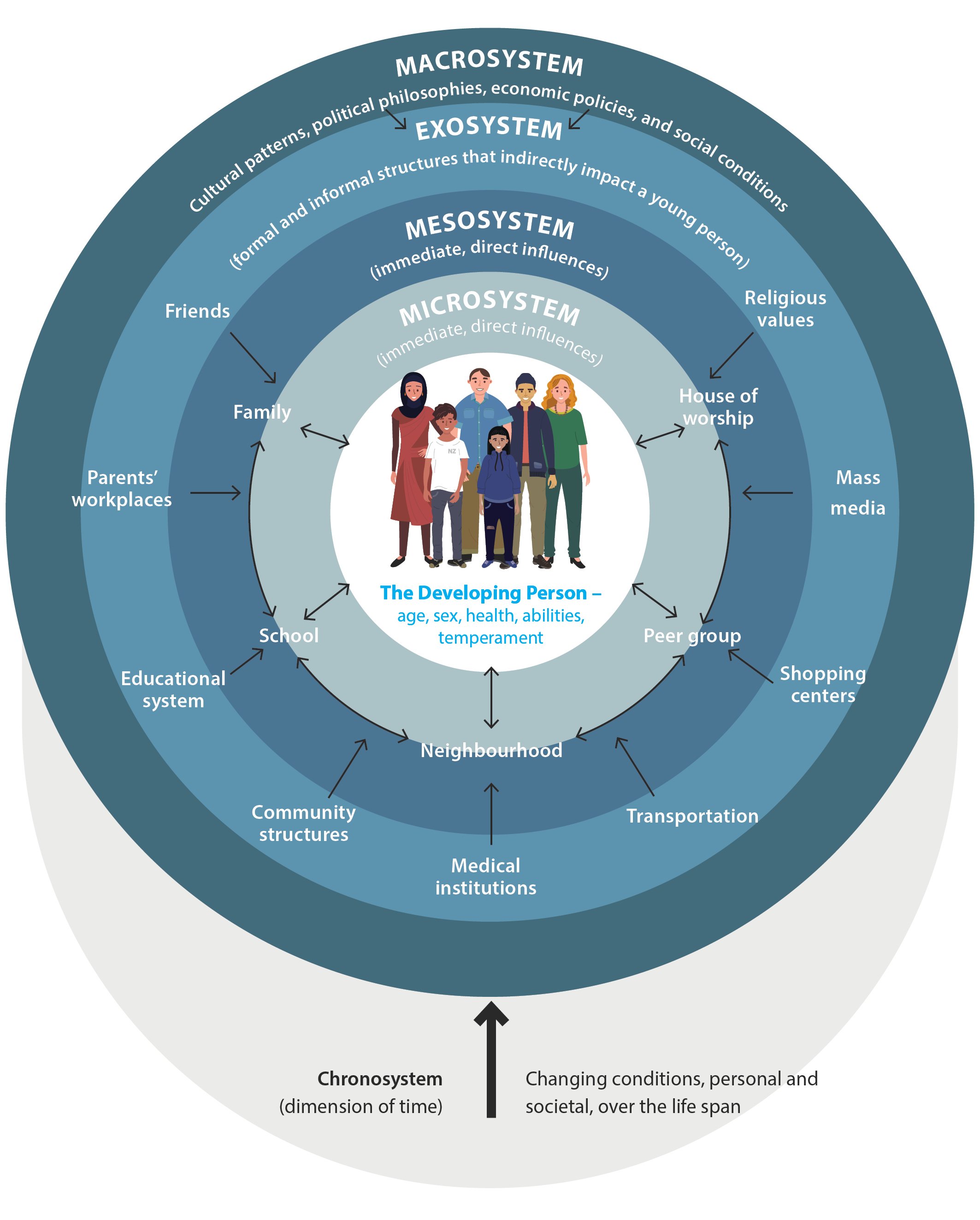A Sociological Perspective
This Idea in Action demonstrates how young people (or any humans for that matter) do not develop in a vacuum on their own, but rather through interactions between themselves and others in a number of contexts or systems. These ideas were first written about by Professor Urie Bronfenbrenner [24], an American psychologist. He created a model that outlines the important contexts that shape a person’s life.
One way to think about this is to consider all of the relationships (large and small, near and far) in a young person’s life and how these contribute in different ways to their growth and development.
Bronfenbrenner saw that every person’s development is shaped by the interaction between an individual (a young person) and their environment (the different environments young people are part of such as whānau, school and community). He talked about this as a two-way process and said that the behaviour and development of people cannot be considered in isolation from their environment. [9] For example, youth development is influenced by:
Individual characteristics such as genetic make-up, physical and cognitive ability, emotional processes, temperament and personality
The environments which young people are directly part of such as home, school, work, sports groups and their community.
The environments which indirectly impact on young people such as larger cultural, political, global and historical contexts.
The interactions that occur in and between these various environments.
According to this view, development occurs as a result of interactions that influence each other (bi-directional) between the unique characteristics of an individual and the social, cultural, historical and biological environments they inhabit. Mutually influential interactions recognise that influence is not one-way, people are not only influenced by the contexts they are in, they exert influence and impact on the contexts they are a part of as well. And each of these contexts influence each other. For example:
A young person is influenced by contexts such as whānau, hapū and iwi, school and workplaces.
This is not a one-way relationship; young people are also active participants in these contexts and they have influence too.
Different contexts also influence each other. Think about the quality of interactions between a whānau and a school or the impact of a stressful workplace on a parent, and how these may impact on a young person.
Now consider broader impacts such as the impact of government policies on issues such as education and employment.
From this we can see that changes to any of the environments that young people are a part of can impact them. This impact may be different for different young people and their whānau. Other examples include:
A new government policy increasing the minimum wage may raise a whānau’s income increasing their ability to provide for their children and young people.
A local youth development organisation gains funding to provide an affordable after school programme which creates an opportunity for a caregiver to go back to work.
A young person chooses to take part in a sports club which helps them to gain skills, confidence, and increases their positive connection to others.
An increase in the cost of housing in an area can mean a whānau moves to find cheaper accommodation which in turn impacts a young person’s schooling and friendships.
A group of young people advocate for more affordable bus fares and improved bus routes which increases access for young people to after school employment opportunities and sporting activities.
Bronfenbrenner reminds us that everything is interconnected and therefore it is important to consider and build the positive connections that young people have in their communities, at school, in their sporting or cultural life and at home to facilitate healthy development.
Bronfenbrenner’s approach has been adopted worldwide and has been shown to align well with indigenous models of development that view development as collective and holistic (e.g. Te Whare Tapa Whā, Meihana Model). The interconnectedness of the contexts in which young people learn and develop is also evident in Te Whāriki.
Bronfenbrenner stated that “all children need at least one other person who is irrationally crazy about them.”
(cited in Brendto, 2006, p.163 [25])
References
[9] adapted from Bronfenbrenner, 1986 [24]
[24] Bronfenbrenner, U. (1986). Ecology of the family as a context for human development: Research perspectives. Developmental Psychology, 22(6), 723–742. Retrieved from https://doi. org/10.1037/0012-1649.22.6.723
[25] Brendto, L. (2006). The vision of Urie Bronfenbrenner: Adults who are crazy about kids. Reclaiming Children and Youth, 15(3), 162-166.
Additional resources
Ricky Baker and Developmental Relationships
In his 2020 article, Lloyd Martin (Praxis) uses Taika Waititi’s film ‘Hunt for the Wilder People’ to explore Uri Bronfenbrenner’s concept of moving from deficit to strengths-based, developmental relationships. The concept illustrates, for Ricky (and every other young person) the four basic needs; to belong, to become good at stuff, to take responsibility and to act generously.
Read the article here


